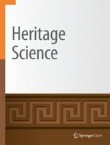
Photo from archive.org
Aged pressure sensitive tapes (PSTs) can compromise the integrity and readability of drawings and paper artworks. Typically, PSTs on contemporary artifacts are difficult to remove owing to degradation processes and… Click to show full abstract
Aged pressure sensitive tapes (PSTs) can compromise the integrity and readability of drawings and paper artworks. Typically, PSTs on contemporary artifacts are difficult to remove owing to degradation processes and to the intrinsic sensitiveness of paper, inks and dyes to the solvents and tools used in the traditional conservation practice. Alternatively, we provide here a critical overview and expansion on the use of two recently developed methodologies for the removal of PSTs, based on the confinement of cleaning fluids in retentive gels. Various combinations of PSTs backings and adhesives were addressed on paper mock-ups containing different types of artistic media (inks, dyes), monitoring the ability of a hydrogel and an organogel to gradually exchange, respectively, an oil-in-water microemulsion or diethyl carbonate through the PSTs backings, swelling the adhesive layers and enabling safe PST removal. It was shown that the two methodologies are complementary as they target the removal of tapes with different components. In all cases, selective tape removal was carried out without uncontrolled bleeding of inks or transport of dissolved matter through the paper matrix, thanks to the retentiveness of the gels. The two cleaning systems were then assessed on four completely different artworks on paper, where they proved to be versatile tools to remove aged PSTs, or re-adhere detackified tapes that were part of the original artwork. Overall, the two methodologies complement each other and allowed overcoming the limitations of traditional cleaning approaches.
Journal Title: Heritage Science
Year Published: 2020
Link to full text (if available)
Share on Social Media: Sign Up to like & get
recommendations!